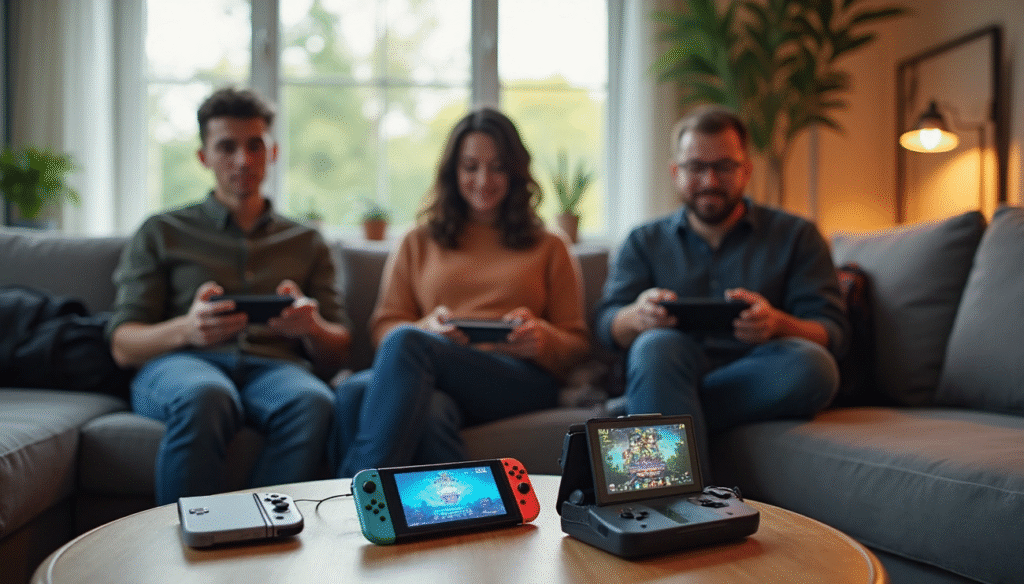Why Handheld Gaming Devices Are Taking Over in 2025: From Niche to Mainstream Success

Handheld gaming devices have taken the market by storm. Nintendo Switch sales hit 143.42 million units by August 2024, making it the third best-selling console of all time. The transformation is amazing. These devices went from a small market segment to a powerhouse in the gaming world.
This handheld gaming boom goes beyond Nintendo’s success story. The Steam Deck, ROG Ally, and MSI Claw have grabbed gamers’ attention. These devices offer both portability and power that players want.
Several factors fuel this radical alteration in gaming preferences. Handheld gaming consoles offer great value for money. Players from different backgrounds can easily afford to buy and use them.
The handheld gaming PC market keeps growing faster than other segments. This growth pattern points to even more expansion as we head into 2025.
The Shift From Game Boy to Steam Deck
Nintendo’s evolution and progress from Game Boy, which launched as a simple monochrome device tells a success story. Certainly, the bulky build laid the foundation as handheld gaming grew popular through the years.
Nintendo introduced vibrant graphics to portable gaming with the launch of Game Boy Color, followed by the Game Boy Advance’s 32-bit processing power. Competitors like Sega’s Game Gear and Sony’s PlayStation Portable tried to claim their market share.
However, the advancement in mobile technology seems like a threat following the development of specialized, high-end gaming smartphones. Many thought that it would be the end of handhelds. Nevertheless, that didn’t happen.
Then came PC-based handheld gaming devices that started the latest revolution. Valve’s Steam Deck, launched in 2022, put a gaming PC in your hands. Others include ASUS’s ROG Ally and Lenovo’s Legion Go. Players can now enjoy thousands of PC games that weren’t available on the go before.
What Makes Today’s Handhelds So Powerful?
Handheld gaming devices have made incredible technical strides in the last five years. These portable powerhouses barely resemble their predecessors except for their simple form factor. They now pack components matching tablets and desktop systems from just a few years back.
Today’s gaming handhelds feature custom-designed APUs that combine CPU and GPU functions into single, power-efficient chips. These specialized processors balance performance and battery life – a constant challenge in portable gaming.
Advanced cooling systems with vapor chambers and liquid metal thermal interfaces help these compact devices maintain optimal temperatures.
The display technology has seen a complete makeover. Latest handheld gaming consoles come with high-refresh OLED and IPS panels.
These screens deliver vibrant colors, deep blacks, and crystal-clear motion that previous generations couldn’t match. Many devices now include adaptive refresh rate technology to save battery life without compromising visual quality.
Storage has evolved significantly. Premium handhelds now come standard with NVMe SSDs, which load games much faster than older systems with cartridges or optical media.
Why Gamers Are Choosing Handhelds?
Gaming in 2025 is all about convenience, and there is no better option than these handheld machines. This trend cuts across all forms of gaming, whether esports, online casinos, sports betting platforms, and real money slots, depending on preference.
Handheld gaming systems help you make the most of your time. Those empty moments during commutes, lunch breaks, queues, or exercise become perfect gaming opportunities. Players need just five minutes to enjoy a quick race or match. These short bursts add up to hours of fun that standard consoles can’t match.
More than half of gamers think about battery life when buying a portable device. Today’s handheld gaming consoles have improved substantially in this area. They run longer on a single charge. Players can now pause and resume their games instantly without losing progress.
Money-conscious gamers often choose handhelds. These economical solutions make sense as energy costs rise. Digital downloads, subscription services, and free-to-play games help cut gaming expenses even more.
What This New Shift Means For The Gaming Industry?
Handheld gaming devices have changed the gaming industry completely. The portable gaming sector has become an economic giant that brings in USD 140.50 billion in revenue. This number is much larger than the USD 35 billion combined revenue of the NFL, MLB, and NBA.
Easy access to games has driven this financial success. Nearly 2 billion mobile gamers now play games worldwide, and games make up more than half of the 300 billion downloaded apps.
Manufacturers now also make high-end devices with up to 1TB of internal storage to hold large game libraries. Business models have changed drastically too. Games are often free to play with in-app purchases available.
This helps developers make money while reaching more players. Experts believe that about 90% of gamers will use cloud gaming services within ten years. So, players can now turn idle moments into gaming sessions.

Jim’s passion for Apple products ignited in 2007 when Steve Jobs introduced the first iPhone. This was a canon event in his life. Noticing a lack of iPad-focused content that is easy to understand even for “tech-noob”, he decided to create Tabletmonkeys in 2011.
Jim continues to share his expertise and passion for tablets, helping his audience as much as he can with his motto “One Swipe at a Time!”
